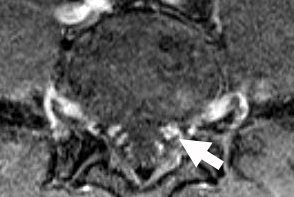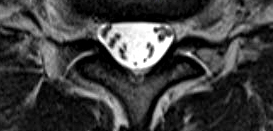PERIPHERAL NERVE: Chronic Demyelination
|
CIDP Demyelination Active Demyelinated axons Focal, Persistent Segmental Hypomyelination Large nerves MMN Onion bulbs Subperineurial edema: CIDP Teased fibers Tomaculae |
MYELIN PATHOLOGY
Myelin Loss: On Preserved Larger Axons
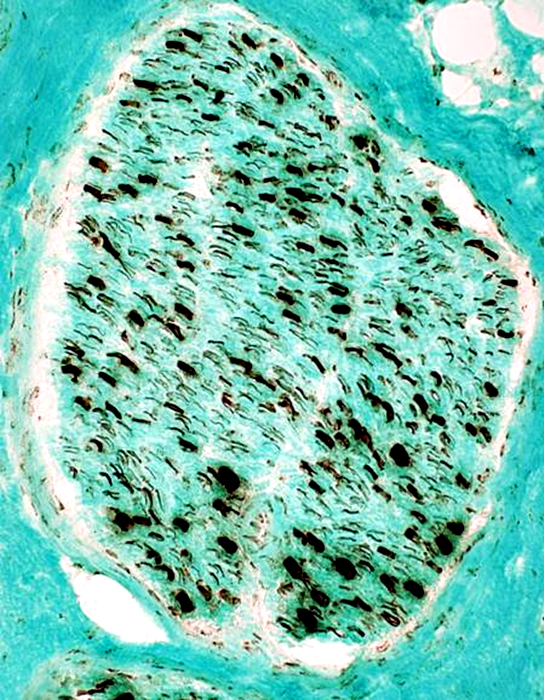 Neurofilament stain Large & Small axons: Present; Reduced numbers
|
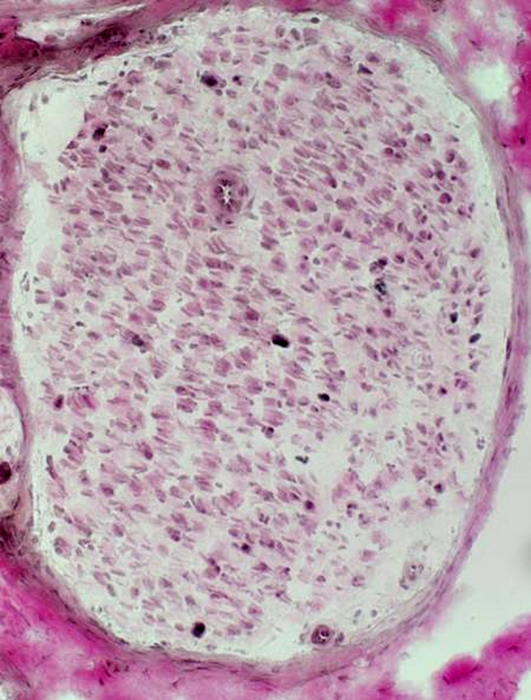 VvG stain Myelin: Mostly absent
|
|
Myelin loss: From preserved larger axons Few remaining myelinated axons are small with thin myelin sheath  Toluidine blue stain Few myelinated axons
|
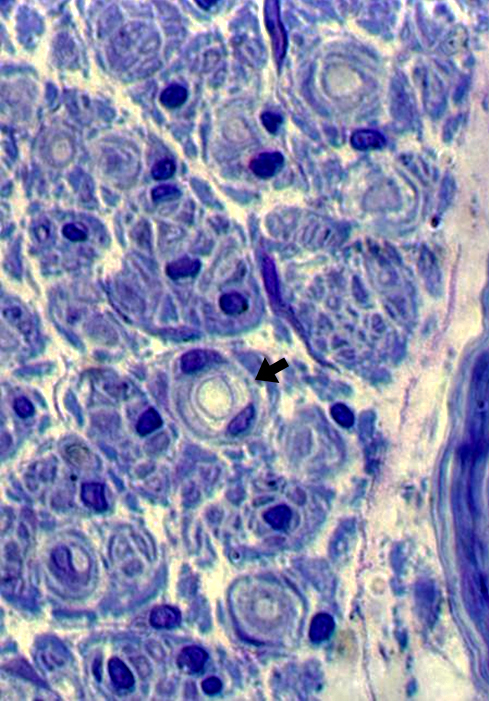 Toluidine blue stain Demyelinated large axons, Scattered (Arrow)
Demyelinated axons often have surrrounding Schwann cells |
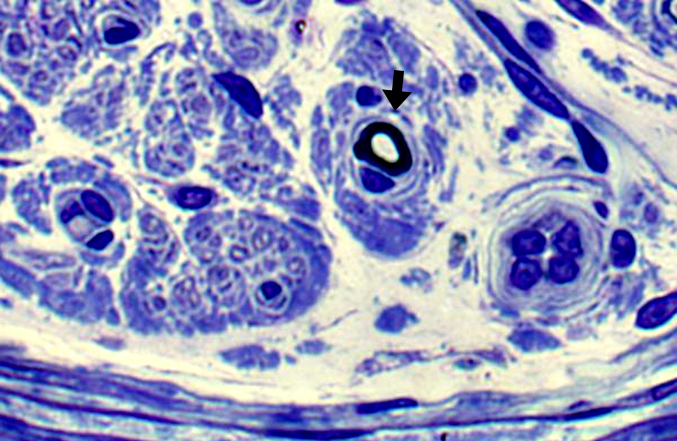 Toluidine blue stain Onion bulb, Early (Arrow): Reduplicated basal lamina |
|
Segmental Demyelination & Remyelination
Segmental Demyelination with Remyelination (Top)Internodes (3)
Short
Different
Lengths
Thicknesses
Control Myelinated Axon (Bottom)
Myelin internode
Long
 Teased Axons |
Myelinated Axons: Segmental Demyelination
Myelination is absent or thin in some internodes but not others
  Teased Axons |
Myelinated Axons: Segmental Demyelination
Myelination of internode is thin to the left of the Node of Ranvier but normal on the right side
 Teased Axons |
CIDP: Distal Motor Axons
Segmental Demyalination
Internode widening
Distal Axons
Thin
Absent myelin
Collateral sprouts: Reinnervate denervated NMJs
 P0-Silver-Esterase stain |
Myelin pathology: Multifocal Motor Neuropathy
 P0-Silver-Esterase stain |
Arrow points to small region of myelin in area of segemental demyelination
Fragment of neuromuscular junction (Blue stain) is at left
Below: Normally myelinated distal motor axon in muscle
Arrow points normal short myelin internode on distal motor axon
 P0-Silver-Esterase stain |
Hypomyelinated Axons
See: PMP-22 point mutation
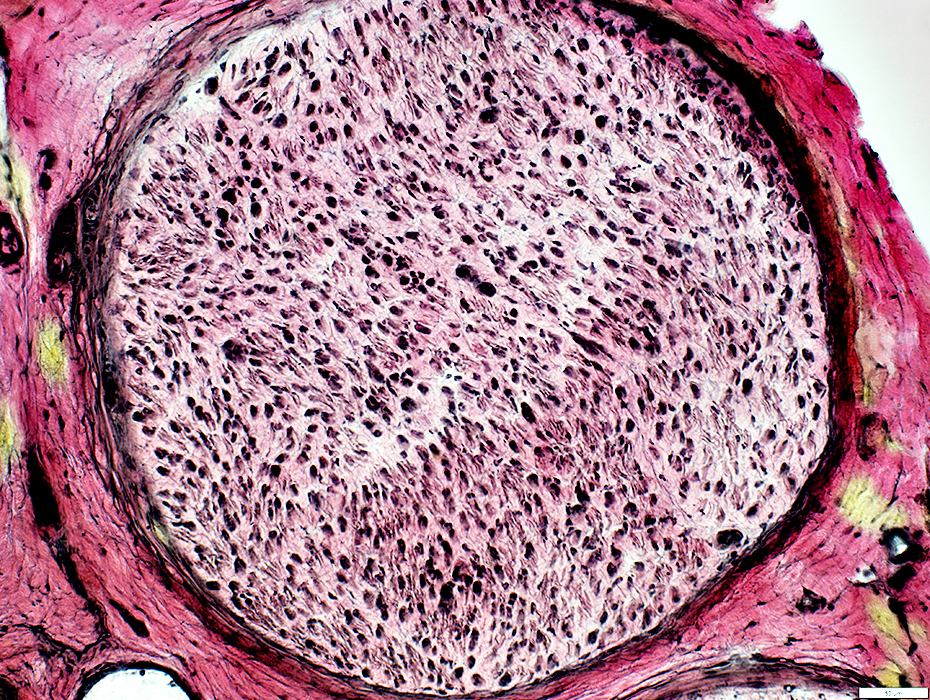 VvG stain |
Cellular
Some increased connective tissue space
No myelin
 VvG stain |
Large axons: Many present with no surrounding myelin space
Small axons: Mildly reduced numbers
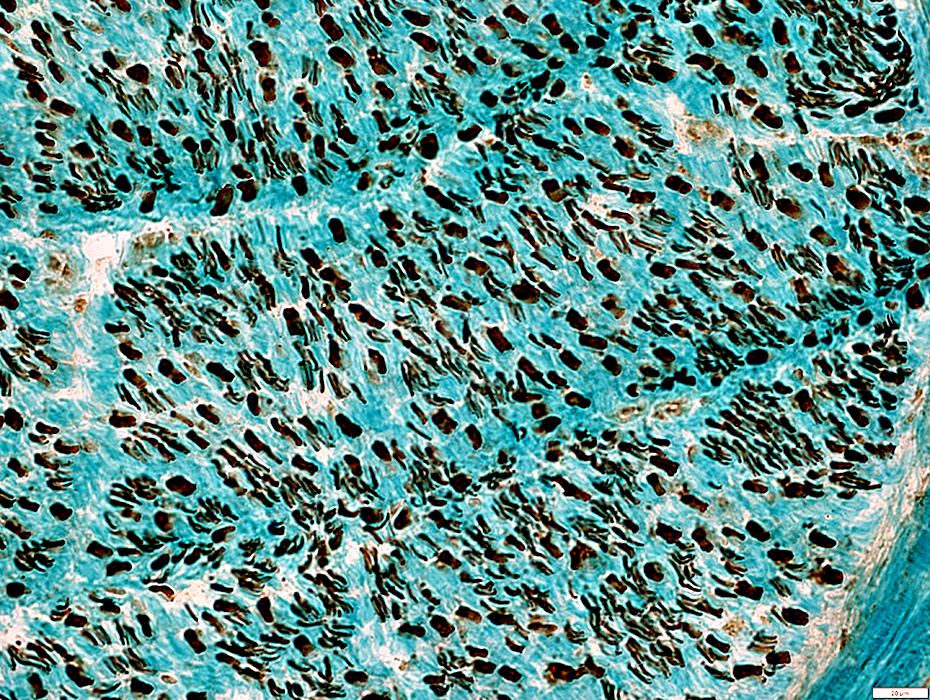 Neurofilament stain |
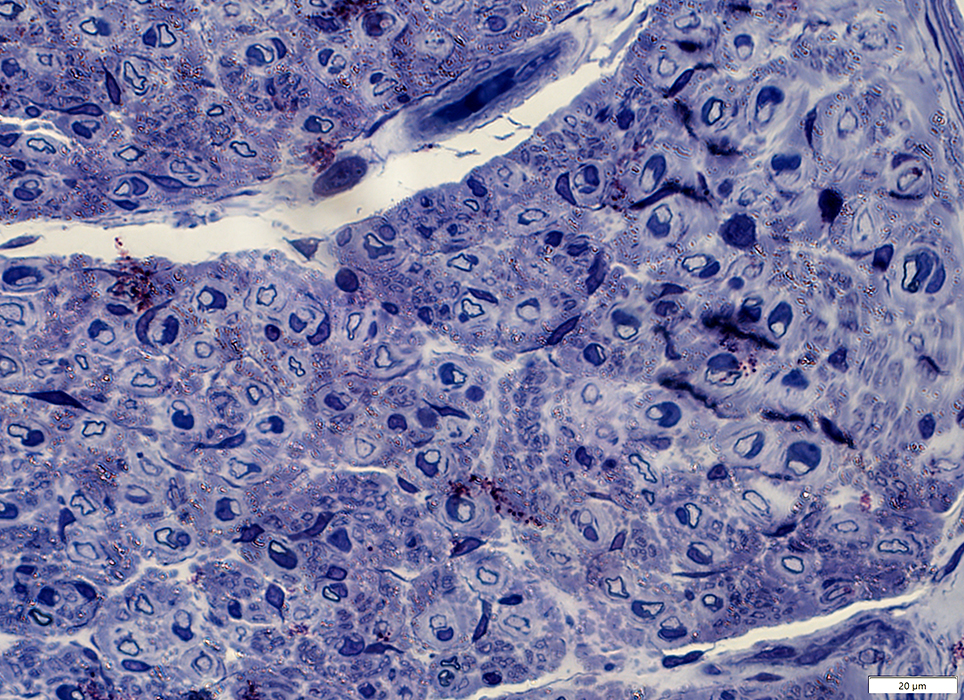 Toluidine blue stain |
Many with very thin surrounding myelin
Schwann cell nuclei often directly neighbor thinly myelinated axons
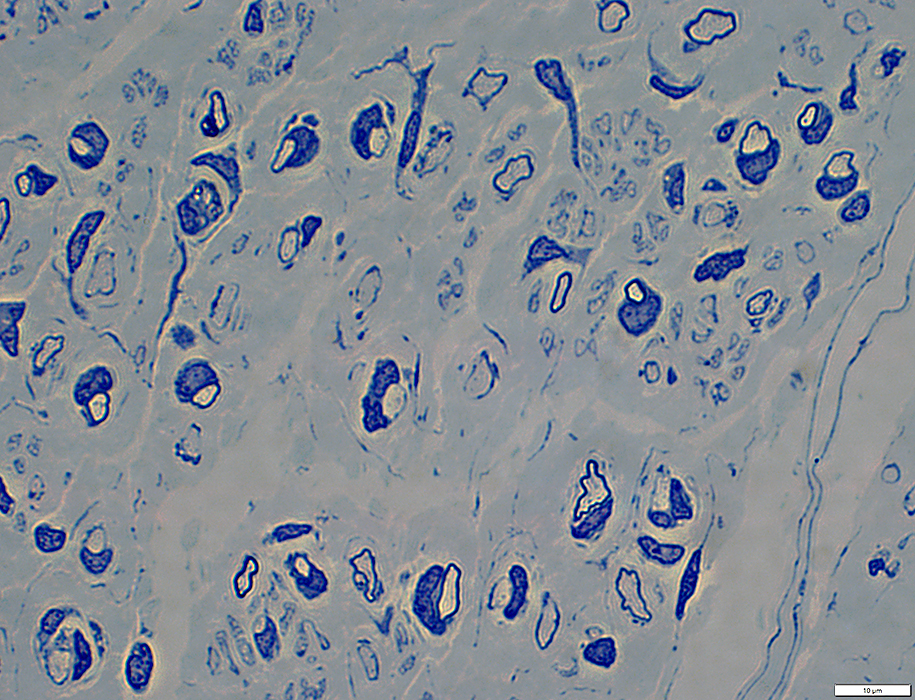 Toluidine blue stain |
Many with very thin surrounding myelin
Schwann cell nuclei often directly neighbor thinly myelinated axons
Endomysial connective tissue
Increased between axons
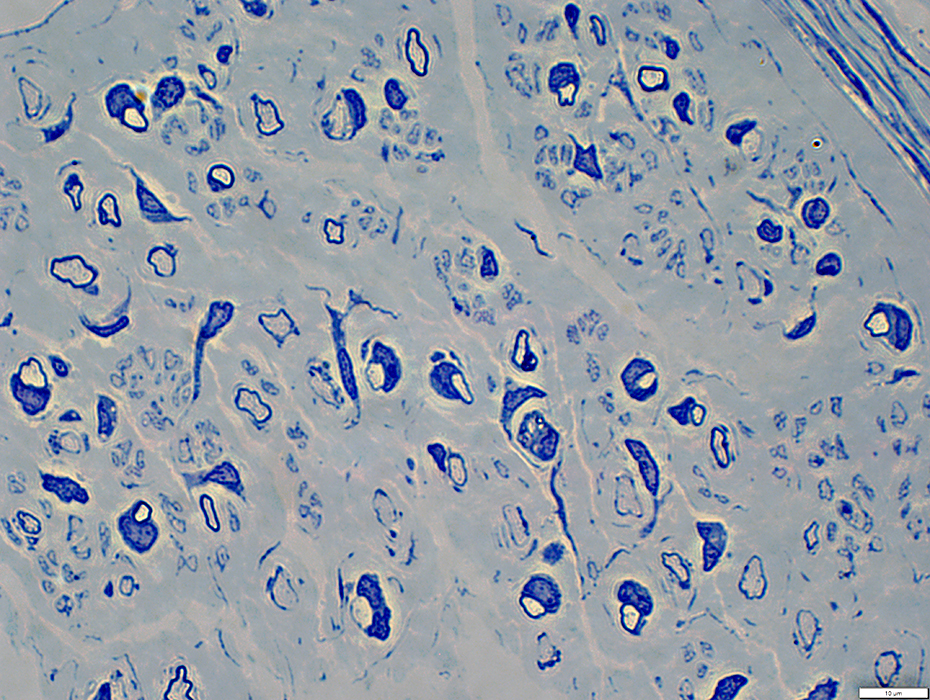 Toluidine blue stain |
ONION BULBS
|
General features BLOBs Early Large Obsolete Molecular Also see CIDP CMT 1 Large nerves Differential Diagnosis Pseudo-Onion bulbs Perineurioma |
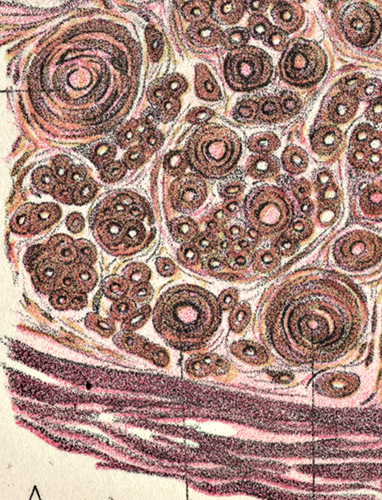 Gombault 1889 |
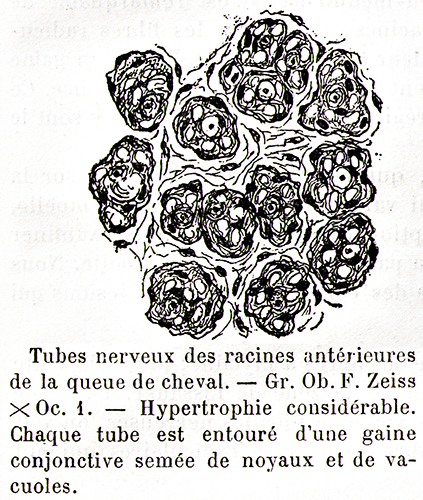 Dejerine & Sottas 1893 |
Onion Bulbs
- Definition
- Circumferentially arranged layers of
- Schwann cell processes
- Schwann cell Basal lamina
- Collagen
- Location: Around axon, or region of axon loss
- Circumferentially arranged layers of
- History
- Early illustrations: Gombault (1889) & Dejerine + Sottas (1893) (Above)
- Cause
- Demyelination & Remyelination: Repeated episodes
- Schwann cell proliferation
- Development
- Remyelination: New Schwann cells add to, or replace, residual Schwann cell
- Onion bulb formation
- Source: Schwann cells & Processes
- Detatch from axon
- Generate cells & processes that form onion bulb layers
- Source: Schwann cells & Processes
- Structure
- Larger axons: Surrounded by NCAM containing Schwann cells & Basal lamina
- Similar in hereditary & immune, acquired demyelinating disorders
- Structures within onion bulb
- Orientation: Circumferential; around axon, if one is present
- Schwann cells: Contain NCAM & P0 protein; "Denervated"
- Basal lamina: Stains for Collagen IV; Between Schwann cell processes
- Collagen strands
- Associated axon
- In center of onion bulb
- Size: Larger size; or May be several, smaller regenerated axons
- Myelin sheath: Around axon; Inside onion bulb; Often thin for axon size, or absent
- Some onion bulbs have no central axon = "Obsolete onion bulbs"
- Other features
- Individual onion bulbs: Often separated from others by increased endomysial connective tissue
- Congenital Hypomyelinating Neuropathies: Onion bulbs have more basal lamina & fewer Schwann cell processes
- Burnt-out or Obsolete onion bulbs
- Loss of central axon within onion bulb
- Eventual loss of associated Schwann cells
- Nerve size
- Often large: Due to presence of onion bulb & increased endomysial connective tissue
- Differential Diagnosis
- Acquired vs Inherited disorders: Patterns of OB distribution
1
- Around most axons: More common with inherited neuropathies
- Around scattered axons: Common with acquired neuropathies
- Clustered in regions of nerve: Acquired or inherited neuropathies
Onion Bulbs, Early
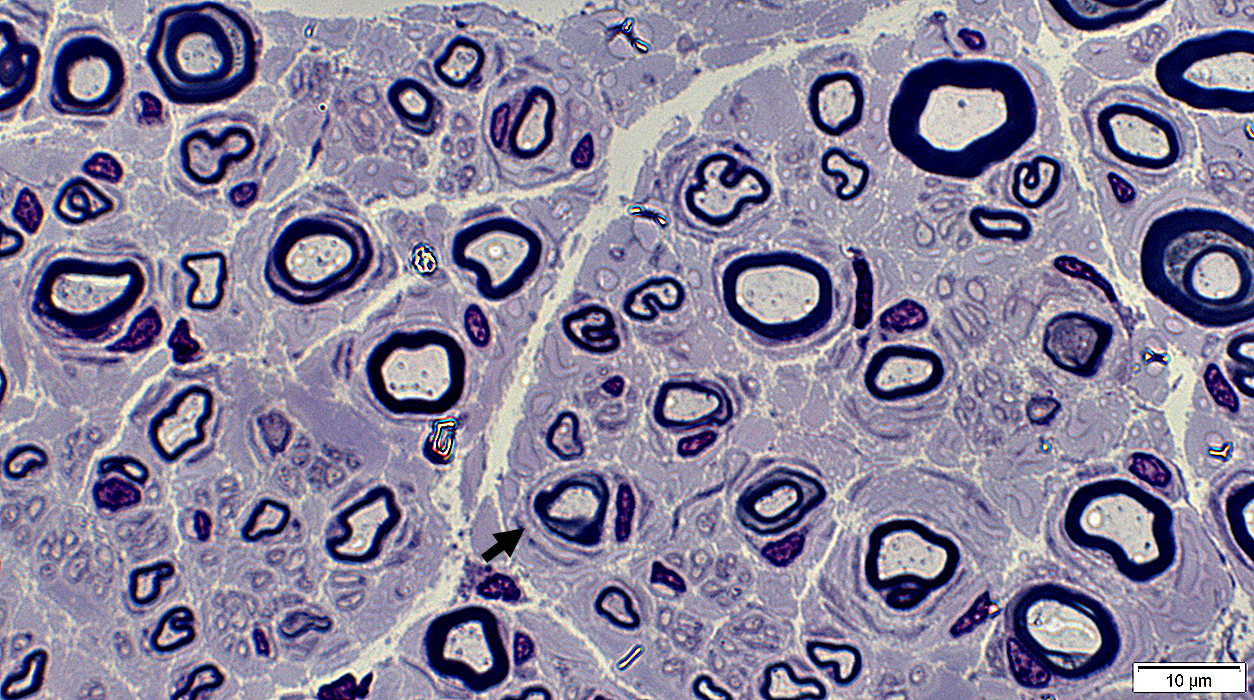 Toluidine blue |
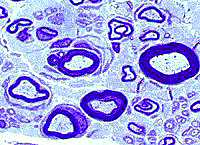 Toluidine blue Onion bulbs, Early Extra layers of Basal lamina, Collagen & Schwann cell processes around thinly or normally myelinated axons. |
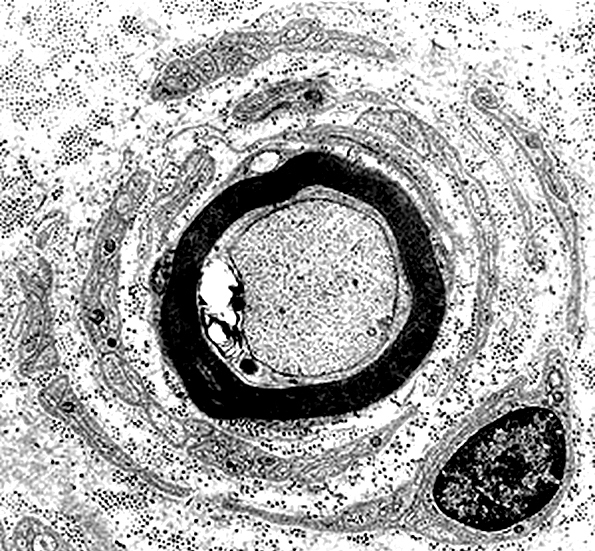 Electron micrograph: From Robert Schmidt MD |
Thinly myelinated, around nerve fibers (Above)
Often related to demyelination
More thickly myelinated, irregular-shaped myelinated axons (Below)
May be related to changes in axon size or regeneration
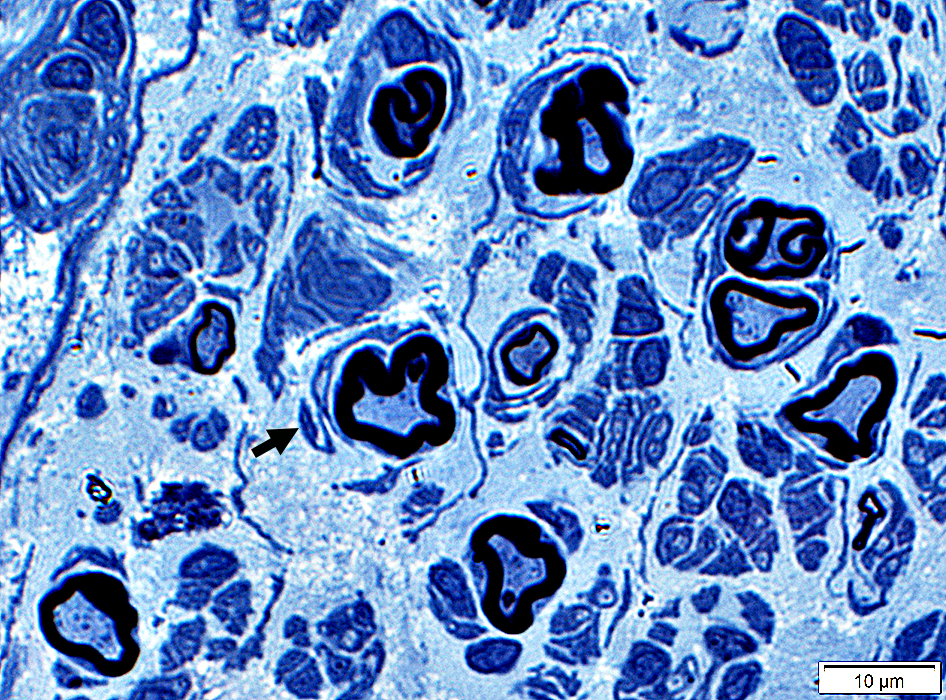 Toluidine blue |
Schwann cell processes & Collagen
May partially surround irregular-shaped myelinated axons
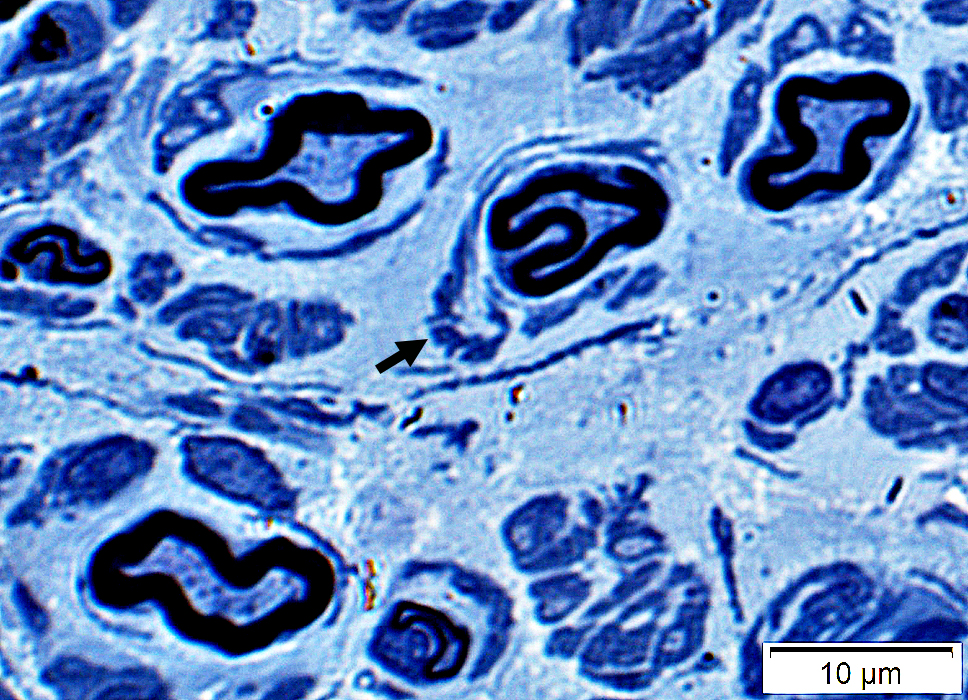 Toluidine blue |
Onion Bulbs: Large, Late
|
Also see: CMT1A |
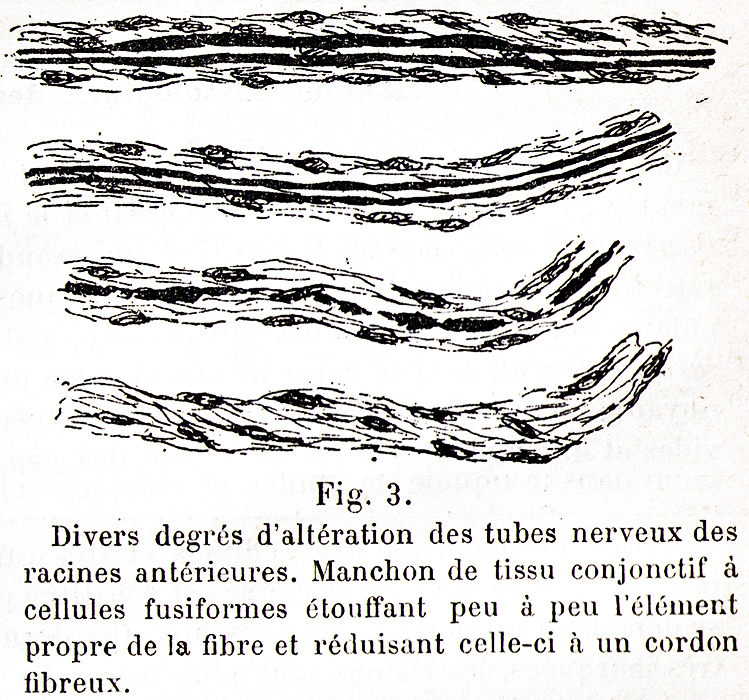 Dejerine & Sottas 1893 |
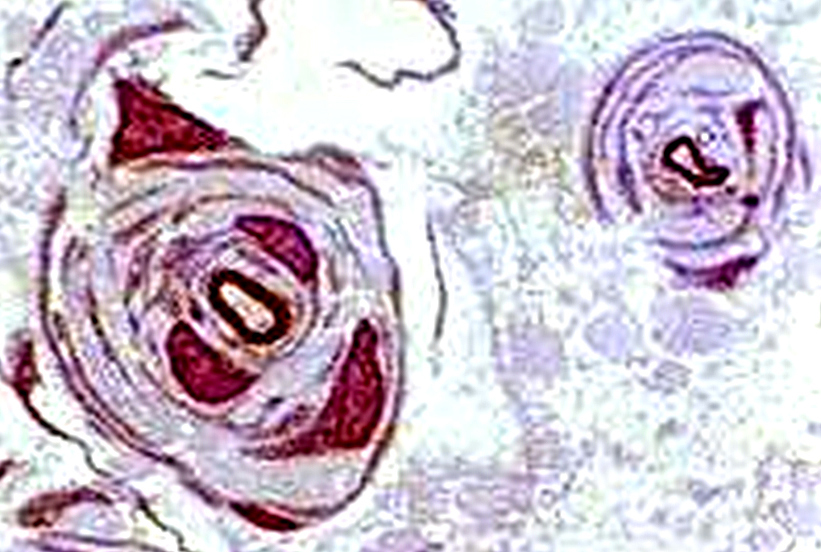 Toluidine blue stains of plastic nerve sections |
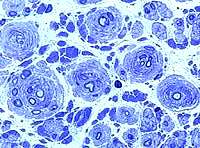 Onion bulbs, Large Multiple Connective tissue layers & Schwann cell processes around thinly myelinated axons. Onion bulbs may contain 0, 1, or several, axons. 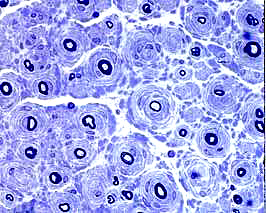 Toluidine blue stains of plastic nerve sections |
|
Onion bulbs, Large Several layers of Basal lamina, Connective tissue & Schwann cell processess around thinly myelinated axons. |
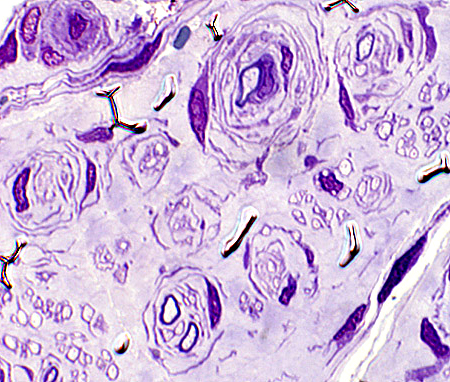
|
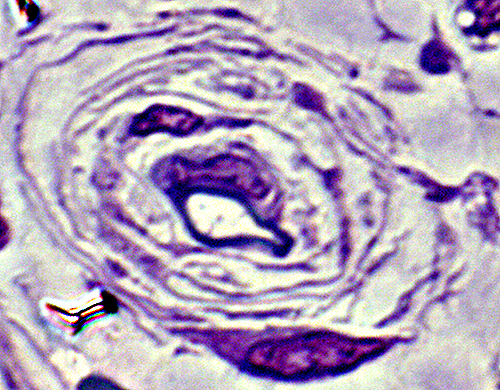
|
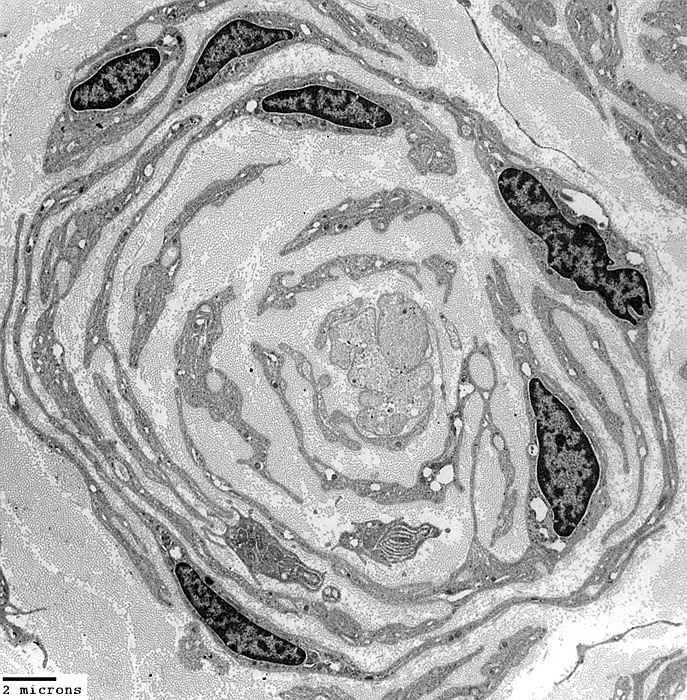 Electron micrographs: From Robert Schmidt MD Onion Bulbs: Obsolete Onion bulbs Multiple layers contain: Schwann cells alternating with collagen Associated axon is: Lost |
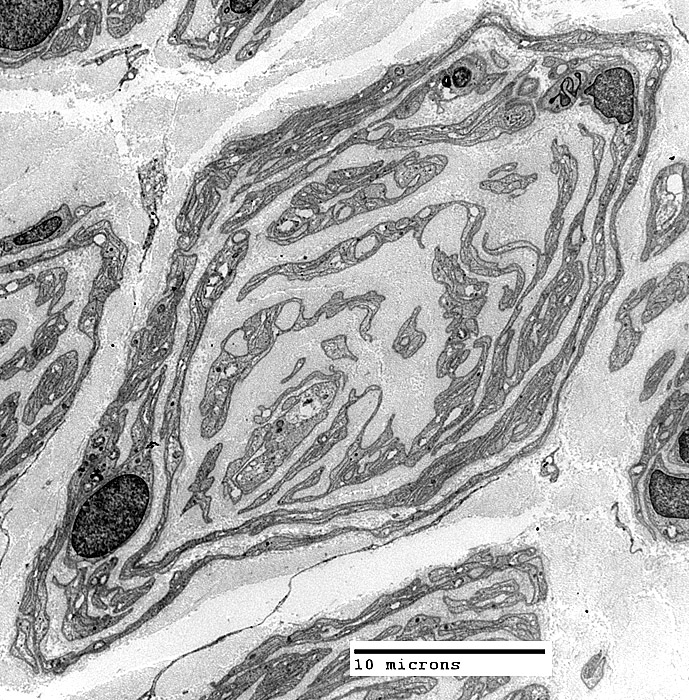
|
Onion bulbs: Molecular composition
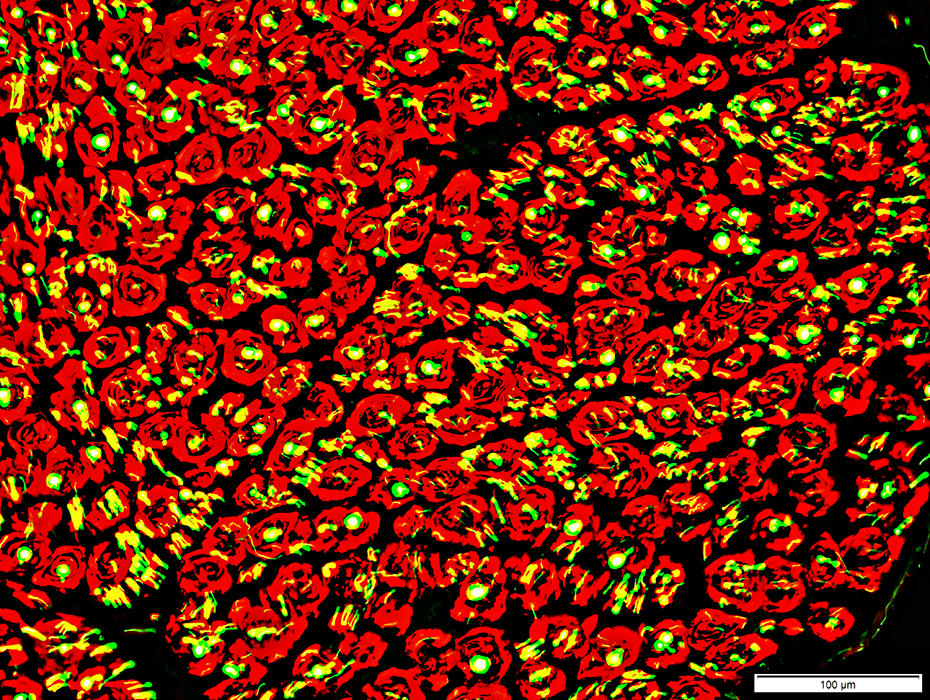 Neurofilament stain (Green) + NCAM stain (Red) |
Surrounded by NCAM containing Schwann cells
Schwann cells in Onion Bulbs
Contain both NCAM (Above) & P0 (Below) (Similar to Büngner band cells)
 Neurofilament stain (Green) + P0 stain (Red) |
Contain both NCAM & P0 (All onion bulb cells cells costain (Below; Yellow))
Similar to Büngner band cells
P0(r).jpg) NCAM stain (Green) + P0 stain (Red) |
Also see
Pseudo-onion bulbs
Perineurioma
Schwann cells & Circumferential Axon Sprouts
Chronic Immune Demyelinating Polyneuropathy (CIDP): Adult
|
Other CIDP pathology Adult Childhood Demyelinated axons Demyelination, Active Differential fascicular Δ Onion bulbs Segmental demyelination Sub-acute onset Thin myelin sheaths Tomacula |
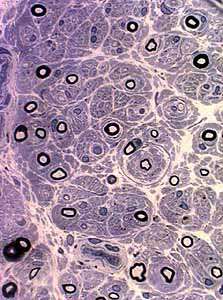 |
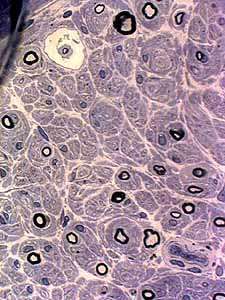 |
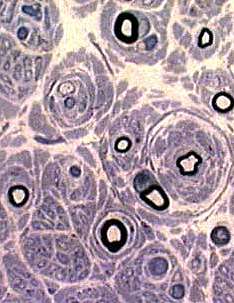 |
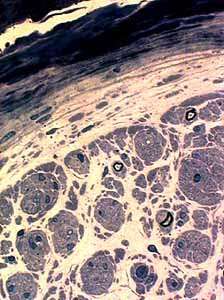 |
|
Remaining axons
Thinly myelinated Reduced numbers |
Onion bulbs: Small
|
||
Sensory CIDP: MRI
Cervical Spinal Cord & Roots: Enlargement & Contrast enhancement of Anterior & Posterior (Arrow) Roots
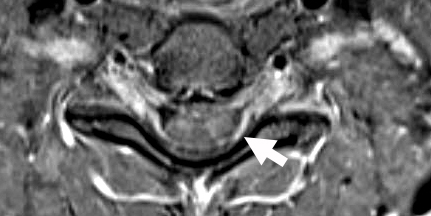 T1 with contrast |
 T1 with contrast |
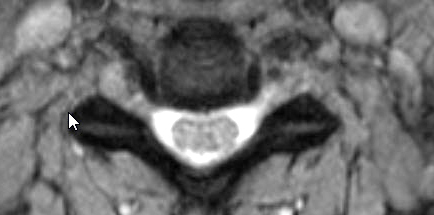 T2 |
Enlargement of Cervical Roots & Brachial plexus (Arrow) T1 with contrast |
|
Return to Normal nerve biopsies
Return to Biopsy illustrations
Return to Neuromuscular Home Page
Return to Nerve biopsy
Return to Demyelinating neuropathies
Return to Active demyelination
References
1. Muscle Nerve 2019;59:665-670
4/28/2024
